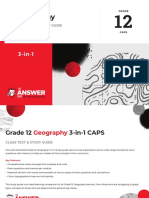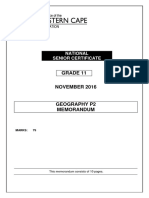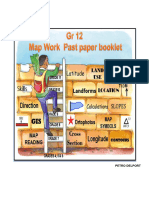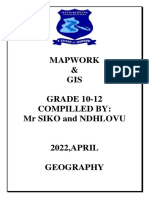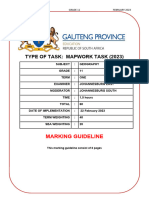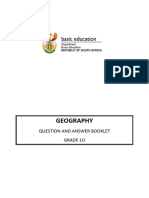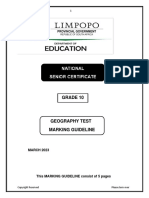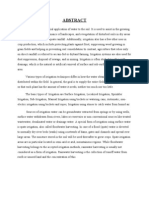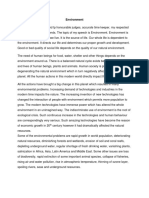Professional Documents
Culture Documents
2023 Geography GR 11 June Exam-1
2023 Geography GR 11 June Exam-1
Uploaded by
fskgaabiOriginal Description:
Original Title
Copyright
Available Formats
Share this document
Did you find this document useful?
Is this content inappropriate?
Report this DocumentCopyright:
Available Formats
2023 Geography GR 11 June Exam-1
2023 Geography GR 11 June Exam-1
Uploaded by
fskgaabiCopyright:
Available Formats
NATIONAL SENIOR CERTIFICATE
GRADE 11
GEOGRAPHY
MID-YEAR EXAMINATION
MAY/JUNE 2023
MARKS : 150
DURATION : 3 hours.
This question paper consists of 20 pages.
Copyright reserved Please turn over
Geography/P1 2 MidyearLoDE/2023
NSC
INSTRUCTIONS AND INFORMATION
1. This question paper consists of TWO SECTIONS:
SECTION A:
QUESTION 1: Atmosphere (60)
QUESTION 2: Geomorphology (60)
SECTION B:
QUESTION 3: Geographical Skills and techniques (30)
2. Answer ALL THREE questions.
3. All diagrams are included in the QUESTION PAPER.
4. Leave a line between the subsections of questions answered.
5. Start EACH question at the top of a NEW page.
6. Number the answers correctly according to the numbering system used in this
question paper.
7. Answer in FULL SENTENCES, except when you have to state, name, identify or list.
8. Units of measurement MUST be indicated in your final answer, e.g 1020hPa, 14 °C
and 45 m.
9. You may use a non-programmable calculator.
10. You may use a magnifying glass.
11. Write neatly and legibly.
SPECIFIC INSTRUCTIONS AND INFORMATION FOR SECTION B
12. Use the 1: 50 000 topographic map 2629DB from Ermelo and a 1:10 000 Orthophoto
map 2629 DB 5 from Ermelo / 1: 50 000 topographic map 3224 BC GRAAFF REINET
and a 1: 10 000 Orthophoto map 3224BC 01 GRAAFF REINET.
13. The area dermacated in RED /BLACK on the topographic map represents the area
covered by the orthophoto map.
14. Show ALL calculations where applicable. Marks will be allocated for this.
15. You must hand in the topographic map and the Orthophoto map to the invigilator at
the end of this examination.
Copyright reserved Please turn over
Geography/P1 3 MidyearLoDE/2023
NSC
SECTION A: THE ATMOSPHERE AND GEOMORPHOLOGY
QUESTION 1: THE ATMOSPHERE
1.1. Refer to FIGURE 1.1 which shows the different angles at which the sun’s rays
strike the Earth’s surface to answer the following questions: Choose either A or
B as your answers.
FIGURE 1.1: THE ANGLE AT WHICH THE SUN’S RAYS STRIKE THE EARTH
Source: google search
1.1.1. At which place do the sun’s rays pass through a larger atmosphere than the
other?
1.1.2. Where do the sun’s rays spread over a larger surface?
1.1.3. At which place will the atmosphere be more intensely heated?
1.1.4. A place with a higher albedo.
1.1.5. A place where the sun’s rays strike the earth at 90° angle.
1.1.6. The sun travels a longer distance before reaching this place.
1.1.7. This place receives insolation throughout the year (7x1) (7)
Copyright reserved Please turn over
Geography/P1 4 MidyearLoDE/2023
NSC
1.2. Refer to the Figure below that shows the relationship between pressure
gradient force and Coriolis force. Choose the correct word(s)/letter(s) from
those given in brackets which will make each statement geographically
CORRECT. Write only the words(s)/letter(s) next to the question numbers
(1.2.1.-1.2.8) in the ANSWER BOOK.
1.2.1. Winds blow flow from (A to B/B to A).
1.2.2. (Coriolis/pressure gradient) force determines the speed at which air moves.
1.2.3. A (Coriolis/pressure gradient) force causes winds to deflect or change
direction in both hemisphere.
1.2.4. In the Southern hemisphere winds deflect to their (left/right).
1.2.5. A (geostrophic/monsoon) wind blows when the pressure gradient and
Coriolis force is equal in strength.
1.2.6. Convergence is associated with a (low/high) pressure.
1.2.7. Subsidence is associated with a (low/high) pressure.
1.2.8. The pressure gradient is (steep/gentle) when isobars are far apart. (8x1) (8)
Copyright reserved Please turn over
Geography/P1 5 MidyearLoDE/2023
NSC
1.3. Study the maps below showing warm, dry winds that blow over the North
American and European continents.
1.3.1. Provide the local names of the warm, dry winds indicated by A and B
in South Africa. (1 x 1) (1)
1.3.2. Is the wet adiabatic lapse rate found on the windward or leeward side? (1 x 2) (2)
1.3.3. Why is the wind dry at A and B on the maps? (2 x 2) (4)
1.3.4. In a paragraph of approximately EIGHT lines, explain the influence
that these warm, dry winds have on economic activities. (4 x 2) (8)
Copyright reserved Please turn over
Geography/P1 6 MidyearLoDE/2023
NSC
1.4. Refer to the figure showing a synoptic weather map of southern Africa.
B A
1.4.1. Give evidence that the synoptic weather map presents
winter conditions. (1x1) (1)
1.4.2. Determine the isobaric interval on the synoptic weather map. (1x1) (1)
1.4.3. Name the high-pressure cell at A. (1x1) (1)
1.4.4. Give TWO general characteristics of high-pressure cell A. (2x2) (4)
1.4.5. How will the position of high-pressure cell B decrease the rainfall over
the western part of the country? (2x2) (4)
1.4.6. Explain how the warm and cold ocean currents on the eastern and
western side of South Africa would control the temperature of
South Africa in winter. (2x2) (4)
Copyright reserved Please turn over
Geography/P1 7 MidyearLoDE/2023
NSC
1.5. Below is an extract on the effects of desertification in the Sahel region.
1.5.1. According to the extract, state ONE human cause of desertification. (1x1)
(1)
1.5.2. Name the region most vulnerable to desertification in Africa. (1x1)
(1)
1.5.3. Why is fertile soil so important to the people of Africa? (1x1)
(1)
1.5.4. What social impact would lack of fertile soil have on the people of Africa?
(2x2) (4)
1.5.5. How does desertification in Senegal have a negative economic impact
on other countries in Africa? (2x2)
(4)
1.5.6. Suggest TWO management strategies that could be implemented
Copyright reserved Please turn over
Geography/P1 8 MidyearLoDE/2023
NSC
to combat (reduce) the spread of desertification. (2x2)
(4)
[60]
QUESTION 2: GEOMORPHOLOGY
2.1. Match a term/word in COLUMN B with the descriptions in COLUMN A. Write ONLY
the letter (A-I) next to the question numbers (2.1.1 – 2.1.8) in the answer sheet, e.g.
2.1.9 J.
COLUMN A COLUMN B
2.1.1. a process whereby a ridge erodes in the A. Lava
direction of a dip slope
2.1.2. The three roundavels are an example of this B. Scarp retreat
2.1.3. A process whereby a soft rock erodes quickly
leaving a hard rock hanging C. Homoclinal shifting
2.1.4. Volcanic rock that forms a plateau on the
surface D. Butte
2.1.5. Molten volcanic rock that erupts on the surface
of the earth E. Undercutting
2.1.6. This process is also known as back wasting
2.1.7. Landscapes that develop out of canyon F. Basalt
landscape
2.1.8. A process in which rocks are broken up into G. Weathering
smaller pieces by mechanical and chemical
processes H. Hilly landscapes
I. Karoo landscapes
(8x1) (8)
Copyright reserved Please turn over
Geography/P1 9 MidyearLoDE/2023
NSC
2.2. Refer to FIGURE 2.2 which indicates a cuesta and a hogsback. Match each of
the descriptions below with sketches A or B
FIGURE 2.2: INCLINED STRATA
2.2.1 Can form in a dome or basin
2.2.2 Has a steep scarp slope and a gentle dip slope
2.2.3 Scarp slope is more than 45˚
2.2.4. It is a suitable location for dams
2.2.5. The gentle dip slope can be used for farming
2.2.6. Composed of steeply tilted strata of rock
2.2.7. Formed by gently tilted rock strata
(7x1) (7)
Copyright reserved Please turn over
Geography/P1 10 MidyearLoDE/2023
NSC
2.3. Study the photos below A and B showing topography associated with massive
igneous rocks.
X Y
2.3.1. What is the difference between intrusive and extrusive igneous rocks? (2 x 1) (2)
2.3.2. Identify igneous landforms X and Y. (2 x 1) (2)
2.3.3. How does landform X form? (2 x 1) (2)
2.3.4. Name TWO characteristics evident in sketch A that is typical of
a batholith. (2 x 1) (2)
2.3.5. Refer to photo B, a dome-shaped landform.
(a) What type of igneous rock is this dome-shaped landform
a characteristic of ? (1 x 1) (1)
(b) Is this dome-shaped landform an example of intrusive or
extrusive igneous rocks? (1 x 1) (1)
(c) Name the type of weathering that occurs on this dome-shaped
landform. (1 x 1) (1)
(d) Explain how this dome-shaped landform has formed. (2 x 2) (4)
Copyright reserved Please turn over
Geography/P1 11 MidyearLoDE/2023
NSC
2.4. Refer to FIGURE 2.4 which shows the typical slope elements/forms
labelled associated with a slope.
FIGURE 2.4: SLOPES
A
2.4.1. Identify the slope elements/forms labelled A, B, C and D. (4x1) (4)
2.4.2. Give ONE characteristic of each of the slope elements/forms
labelled D and B (2x2) (4)
2.4.3. Which slope element is best suited for crop farming? Give a reason
for your answer. (1+2) (3)
2.4.4. Slopes provide a valuable piece of land for mankind. Discuss the
significance of slopes for human activity. (2x2) (4)
Copyright reserved Please turn over
Geography/P1 12 MidyearLoDE/2023
NSC
2.5. Study figure 2.5 below showing mass movement.
2.5.1. Define the concept mass movement. (1x2) (2)
2.5.2. What type of mass movement is illustrated in FIGURE 2.5.? (1x1) (1)
2.5.3. Provide evidence from FIGURE 2.5. that mass movement is
taking place. (1x2) (2)
2.5.4. Provide any negative impact of the mass movement indicated
in figure 2.5. (1x2) (2)
2.5.5. In paragraph of approximately EIGHT lines, discuss strategies that
can be used to minimize, the effects of mass movements. (4x2) (8)
[60]
Copyright reserved Please turn over
Geography/P1 13 MidyearLoDE/2023
NSC
SECTION B
QUESTION 3: GEOGRAPHICAL SKILLS AND TECHNIQUES
Copyright reserved Please turn over
Geography/P1 14 MidyearLoDE/2023
NSC
3.1. MAP SKILLS AND CALCULATION
3.1.1. The contour interval of the Orthophoto map is ……..
A 50 meters
B 20 meters
C 5 meters
D 10 meters (1x1) (1)
3.1.2. The altitude of the trig beacon in block D2 on the topographical map
is……
A. 305
B. 350
C. 1736.8
D. 1763.8 (1x1) (1)
3.1.3. Calculate the length of the dam wall in Block C3 in meters. (2x1) (2)
3.1.4. Calculate the vertical exaggeration of the slope on the
orthophoto map.
Use the following information:
Vertical scale: 1cm is to 20m
Horizontal scale is shown on the topographical map
VS
Formula VE= (5x1) (5)
HS
3.1.5. State the direction of the Opencast Mine at D1 and E1 on the
topographical map from Rietspruit in block D2 (1x1) (1)
Copyright reserved Please turn over
Geography/P1 15 MidyearLoDE/2023
NSC
3.2. MAP INTERPRETATION
3.2.1. In which province is Ermelo located……
A. Limpopo
B. Gauteng
C. Mpumalanga
D. North west (1x1) (1)
3.2.2.The curved contour lines in (D1, C1 and C2) on the Orthophoto map
represent
A. Spur
B. Mountain
C. Valley
D. Excavations (1x1) (1)
3.2.3. Refer to the river in block D3 on the topographic map 2629DB Ermelo
and answer questions that follow.
(a) Is the river perennial or non-perennial? (1x1) (1)
(b) Determine the general flow of the river. (1x1) (1)
(c) Provide a reason to support your answer in 3.2.1 (b). (1x2) (2)
3.2.4. Refer to block D1 on the topographic map
(a) Identify the type of slope evident in block D1. (1x1) (1)
(b) Identify the type of mining evident in the block D1. (1x1) (1)
(c) Give two sources of water evident in block D1 that support the
farming community (2x1) (2)
3.2.5. Give the specific name of road passing through C2, D2 and D3 on
the orthophoto map. (You may also refer to the topographical map) (1x2) (2)
Copyright reserved Please turn over
Geography/P1 16 MidyearLoDE/2023
NSC
GEOGRAPHICAL INFORMATION SYSTEMS (GIS)
3.3.1. Is Orthophoto map of Ermelo a vector or Raster map? (1x1) (1)
3.3.2. Give a reason to support your answer to QUESTION 3.3.1. (1x2) (2)
3.3.3. Refer to the photograph below about remote sensing.
(a) Define the concept remote sensing. (1 x 2) (2)
(b) State one advantage of remote sensing (1 x 1) (1)
(c) Name two examples of remote sensing (2 x 1) (2)
[30]
OR
Copyright reserved Please turn over
Geography/P1 17 MidyearLoDE/2023
NSC
Copyright reserved Please turn over
Geography/P1 18 MidyearLoDE/2023
NSC
QUESTION 3: GEOGRAPHIC SKILLS AND TECHNIQUES
3.1 MAP SKILLS AND CALCULATION
Study the topographic and orthophoto map and answer questions that follow
3.1.1. The contour interval in block C1 on the Orthophoto map is …. (1x1) (1)
A. 50 meters
B. 20 meters
C. 5 meters
D. 10 meters
3.1.2. The altitude of the trig beacon found in block C9 on the topographical
map is ……
A. 89
B. 98
C. 1066.7
D. 1077.6 (1x1) (1)
3.1.3. Calculate the length of the dam wall in Block K8 and K9. Give your
answers in meters. (2x1) (2)
3.1.4. (a) Calculate the vertical exaggeration of the slope on the
orthophoto map.
Use the following information:
Vertical scale: 1cm is to 20m
The Horizontal scale is shown on the topographical map
VS
Formula VE=
HS
(5x1) (5)
3.1.5. State the direction of Excavation at H7 on the topographical map
from Edenvale in Block H9. (1x1) (1)
(10)
Copyright reserved Please turn over
Geography/P1 19 MidyearLoDE/2023
NSC
3.2. MAP INTERPRETATION
3.2.1. In which province is Graaf-Reinet found
A. Limpopo
B. Mpumalanga
C. Eastern cape
D. Western Cape (1x1) (1)
3.2.2. The curved contour lines in (E2 to D2) on the Orthophoto map
represent
A. Spur
B. Mountain
C. Valley
D. Excavations (1x1) (1)
3.2.3. Refer to the river in block K9 on the topographic map
3224 Graaf-Reinet (south) and answer questions that follow.
(a) Is the river perennial or non-perennial? (1x1) (1)
(b) Determine the general flow of the river. (1x1) (1)
(c) Provide the reason to support your answer in 3.2.1 (b). (1x2) (2)
3.2.4. Refer to the topographic map to answer the following questions:
(a) Identify the type of slope represent by Letter B in block E3 on
the topographic map. (1x1) (1)
(b) Identify the feature labelled A in block H7 and H8. (1x1) (1)
(c) Give two sources of water evident in block K7and 8 that support
the farming community. (2x1) (2)
3.2.5. Give the specific name of road passing through B5 up to C5 on the
Orthophoto map. (1x2) (2)
(12)
Copyright reserved Please turn over
Geography/P1 20 MidyearLoDE/2023
NSC
3.3. GEOGRAPHICAL INFORMATION SYSTEMS
3.3.1. Is Orthophoto map of Graaf-Reinet a vector or Raster map? (1 x 1) (1)
3.3.2. Give a reason to support your answer to QUESTION 3.3.1. (1 x 2) (2)
3.3.3. Refer to the photograph below about remote sensing.
(a) Define the concept remote sensing. (1 x 2) (2)
(b) State one advantage of remote sensing (1 x1) (1)
(c) Name two examples of remote sensing (2 x 1) (2)
(8)
[30]
Copyright reserved Please turn over
You might also like
- GR 11 RELAB - NOTES AND ACTIVITIES - EditedDocument119 pagesGR 11 RELAB - NOTES AND ACTIVITIES - Editedqomoyinhlanhla129100% (2)
- KZN LFSC Grade 10 Step Ahead Teacher Support Document 2023Document28 pagesKZN LFSC Grade 10 Step Ahead Teacher Support Document 2023OlwethuNo ratings yet
- Math Lit Learner Relab Grade 11 Term 1 - 4Document62 pagesMath Lit Learner Relab Grade 11 Term 1 - 4coolkidkwaneleNo ratings yet
- GRADE 10 RELAB NOTES and ACTIVITIES - Compressed PDFDocument116 pagesGRADE 10 RELAB NOTES and ACTIVITIES - Compressed PDFOratile100% (8)
- Math Lit Session 1 - 4 Learner Guide 2023 EnglishDocument21 pagesMath Lit Session 1 - 4 Learner Guide 2023 EnglishDonald Ncube80% (5)
- The Impacts of Drought in South AfricaDocument10 pagesThe Impacts of Drought in South Africaadelaidekegaogetswe0% (1)
- Mathematics GR 9 Investigation Term 2 MEMORANDUM Congruency and SimilarityDocument9 pagesMathematics GR 9 Investigation Term 2 MEMORANDUM Congruency and Similaritythabo50% (2)
- Grade 11 Geography Atmosphere NotesDocument125 pagesGrade 11 Geography Atmosphere Notesprismred1100% (2)
- Life Sciences GR 11 Exam Guidelines 2023 EngDocument18 pagesLife Sciences GR 11 Exam Guidelines 2023 Engtendanim23No ratings yet
- Geography Grade 11 Revision Term 2 - 2021Document18 pagesGeography Grade 11 Revision Term 2 - 2021mpho makhafula100% (2)
- Grade 11 Relab MemoDocument50 pagesGrade 11 Relab Memomudauvhulenda817100% (1)
- Gr11 Geography Learner Activities Term 1Document65 pagesGr11 Geography Learner Activities Term 1YONDELA Mbandezelo100% (2)
- Grade 8 History Learners Book Unit 2 Term 2Document18 pagesGrade 8 History Learners Book Unit 2 Term 2Zelda Juffrou Snyman100% (1)
- MAPWORK TASK TERM 2 MEMO - ERMELO FinalDocument9 pagesMAPWORK TASK TERM 2 MEMO - ERMELO FinalMoagi Lekaka100% (3)
- Mathematical Literacy GR 11 Paper 1 - 1Document9 pagesMathematical Literacy GR 11 Paper 1 - 1angelinerayners73No ratings yet
- Geography Grade 11 Revision Answers Terms 3 and 4 - 2021-1Document19 pagesGeography Grade 11 Revision Answers Terms 3 and 4 - 2021-1Macia50% (2)
- Math - Grade - 11 - P2 June 2023 QPDocument10 pagesMath - Grade - 11 - P2 June 2023 QPKarlos 03No ratings yet
- GR 12 Geography 3 in 1 ExtractsDocument15 pagesGR 12 Geography 3 in 1 ExtractsJinNo ratings yet
- Life Orientation GR 11 MEMODocument11 pagesLife Orientation GR 11 MEMOKgothatso Musi100% (2)
- Geography Grade 11 Term 2 Week 1 - 2020Document3 pagesGeography Grade 11 Term 2 Week 1 - 2020mpho makhafulaNo ratings yet
- Geography Grade 12 Term1 Week 1 To 3Document50 pagesGeography Grade 12 Term1 Week 1 To 3Nkhensani Hlungwani100% (1)
- Grade 11 Geography Exam Papers and Memos PDFDocument2 pagesGrade 11 Geography Exam Papers and Memos PDFAndrew64% (22)
- Meteorology Questions EASADocument27 pagesMeteorology Questions EASAONURNo ratings yet
- English GR 10 HL Paper 1Document10 pagesEnglish GR 10 HL Paper 1Lathitha100% (1)
- Grade 9 Geography Baseline FinalDocument24 pagesGrade 9 Geography Baseline FinalFifie OjifinniNo ratings yet
- Physical Sciences P1 Feb-March 2011 EngDocument19 pagesPhysical Sciences P1 Feb-March 2011 EngnaidoowendyNo ratings yet
- GEOGRAPHY P1 GR10 QP NOV2018 - EnglishDocument16 pagesGEOGRAPHY P1 GR10 QP NOV2018 - EnglishAndzaniNo ratings yet
- Mapwork Techniques Term 1 2023 Practical Task PDFDocument94 pagesMapwork Techniques Term 1 2023 Practical Task PDFMoagi LekakaNo ratings yet
- Capricorn North District 2023 Term 1 Formal Assessment Geography Grade 12 Task1: Mapwork Task 01 MARCH 2023 MARKS: 60 Duration: 1.5 HoursDocument7 pagesCapricorn North District 2023 Term 1 Formal Assessment Geography Grade 12 Task1: Mapwork Task 01 MARCH 2023 MARKS: 60 Duration: 1.5 HoursShaun Lebepe50% (2)
- Grade 10 Relab Notes and ActivitiesDocument124 pagesGrade 10 Relab Notes and ActivitiesNeo Ntsakiso100% (1)
- Gr11 Geog p2 n16 Memo EngDocument10 pagesGr11 Geog p2 n16 Memo EngThato MotlhabaneNo ratings yet
- Grade 11 Geography Exam Papers and Memos PDFDocument2 pagesGrade 11 Geography Exam Papers and Memos PDFChrispenbero ChriberoNo ratings yet
- Mapwork Task Memo Grade 10 2023Document11 pagesMapwork Task Memo Grade 10 2023zinhlecolette35100% (2)
- Mapwork Past Paper BookletDocument111 pagesMapwork Past Paper Bookletkmahlangu391No ratings yet
- AGRIC SCIENCES P2 GR11 MEMO NOV2022 - EnglishDocument8 pagesAGRIC SCIENCES P2 GR11 MEMO NOV2022 - EnglishNthabeleng RamotseoaNo ratings yet
- ASSESSMENT Geography Climate Regions Assessment GR 8 T2 Assessment PrintoutDocument9 pagesASSESSMENT Geography Climate Regions Assessment GR 8 T2 Assessment PrintoutUKiid Aarh Loh BafethuNo ratings yet
- Type of Task: Mapwork Task Exampler (2024)Document11 pagesType of Task: Mapwork Task Exampler (2024)londielondie48No ratings yet
- 2023 Grade 11 Term 3 Investigation Memo FINALDocument4 pages2023 Grade 11 Term 3 Investigation Memo FINALNISSIBETI50% (2)
- Geomorphology-3 CompressedDocument54 pagesGeomorphology-3 Compressednoxolo dwane100% (3)
- English FAL P2 QPDocument24 pagesEnglish FAL P2 QPDoktha Gebuza KhozaNo ratings yet
- Physical Sciences Grade 11 Term 1Document48 pagesPhysical Sciences Grade 11 Term 1Michael Akintola100% (1)
- Mapwork & GIS GRADE 10-12 Compilled By: MR Siko and NdhlovuDocument51 pagesMapwork & GIS GRADE 10-12 Compilled By: MR Siko and NdhlovuOratileNo ratings yet
- Grade 12 Geography Mapwork Learner BookDocument46 pagesGrade 12 Geography Mapwork Learner BookLamiya BalochNo ratings yet
- GR 11 Relab Tourism Learner GuideDocument156 pagesGR 11 Relab Tourism Learner Guideditsekeamogetswe37No ratings yet
- Grade 11 Mapwork Task Option 1 Memo ErmeloDocument8 pagesGrade 11 Mapwork Task Option 1 Memo Ermelozinhlecolette3550% (2)
- GR 10 Geography Question Paper BookletDocument73 pagesGR 10 Geography Question Paper BookletMpho ShoddaNo ratings yet
- Ssip Mathematics Term 1 2024 Ssip For Learners - 1 Grade 11Document44 pagesSsip Mathematics Term 1 2024 Ssip For Learners - 1 Grade 11ngcokomanielethueNo ratings yet
- GR 11 Relab - Notes and Activities - CompressedDocument123 pagesGR 11 Relab - Notes and Activities - Compressedmudauvhulenda817No ratings yet
- NW NSC GR 10 Geography p1 Eng Nov 2019Document17 pagesNW NSC GR 10 Geography p1 Eng Nov 2019amandamkhwenkwe69No ratings yet
- 2023 Maths Lit Grade 10 June Exam p2 EngDocument6 pages2023 Maths Lit Grade 10 June Exam p2 EngzanelemvubeloNo ratings yet
- Maths Grade 11 P1 Second Push 2023Document6 pagesMaths Grade 11 P1 Second Push 2023elepeachs100% (2)
- Life Science SEPTEMBER 2023 Grade 11 2023Document7 pagesLife Science SEPTEMBER 2023 Grade 11 2023Karlos 0350% (2)
- Zoom in Mapskills Grade 11: Task 1: VelddrifDocument6 pagesZoom in Mapskills Grade 11: Task 1: VelddrifJaryd GovenderNo ratings yet
- Grade 11 LO Exam MEMO Term 2 2018 Final 1Document11 pagesGrade 11 LO Exam MEMO Term 2 2018 Final 1ora mashaNo ratings yet
- Grade 11 LO Exam Term 4 2020 NovemberDocument8 pagesGrade 11 LO Exam Term 4 2020 NovemberLamees IdrisNo ratings yet
- Maths Lit p1 Gr11 QP Nov 2018Document16 pagesMaths Lit p1 Gr11 QP Nov 2018Christel LootsNo ratings yet
- Grade 10 June Exam Marking Guideline 2023-2Document9 pagesGrade 10 June Exam Marking Guideline 2023-2Masimo SeforaNo ratings yet
- Grade 8 and 9 Item Banks For RevisionDocument131 pagesGrade 8 and 9 Item Banks For RevisionNhlanzeko Nhlanzeko100% (1)
- Geography GRD 10 MG 2023 PDFDocument4 pagesGeography GRD 10 MG 2023 PDFLebo NdamaseNo ratings yet
- Grade 11 Life Orientation 2024Document5 pagesGrade 11 Life Orientation 2024koreanni151No ratings yet
- English First Additional Language Grade 11 Literature Madule Short Stories Lesson Plan 2019 Questions and AnswersDocument20 pagesEnglish First Additional Language Grade 11 Literature Madule Short Stories Lesson Plan 2019 Questions and Answersthulithwala04No ratings yet
- Earth and Life Science Quarter 1 Week 5Document3 pagesEarth and Life Science Quarter 1 Week 5thessaeuste22No ratings yet
- Types of Irrigation Schemes and Methods of Field Water ApplicationDocument34 pagesTypes of Irrigation Schemes and Methods of Field Water ApplicationDurgaprasad Gajengi0% (1)
- Cev 513 Hydrology Robin Tuble, Kent Calilung, Mykel Besavilla, Christian CaitanDocument18 pagesCev 513 Hydrology Robin Tuble, Kent Calilung, Mykel Besavilla, Christian CaitanRobin TubleNo ratings yet
- Ecological Restoration and Planning For Alang-Sosiya Ship-Breaking Yard, GujaratDocument8 pagesEcological Restoration and Planning For Alang-Sosiya Ship-Breaking Yard, GujaratDebiGoenkaCATNo ratings yet
- Rain Water Harvesting Project PDFDocument61 pagesRain Water Harvesting Project PDFSachin ShindeNo ratings yet
- EcosystemDocument2 pagesEcosystemJAPHET NKUNIKANo ratings yet
- Dams and BarragesDocument3 pagesDams and BarragesTariq Ahmed0% (1)
- French Weather PhrasesDocument7 pagesFrench Weather PhrasesAditi RaneNo ratings yet
- Eglinton Et Eglinton - 2008 - Molecular Proxies For PaleoclimatologyDocument16 pagesEglinton Et Eglinton - 2008 - Molecular Proxies For PaleoclimatologyGabriela BravimNo ratings yet
- QUIZ - Coping With Hydrometeorological HazardsDocument1 pageQUIZ - Coping With Hydrometeorological HazardsCristina MaquintoNo ratings yet
- Making A Weather Oral ReportDocument3 pagesMaking A Weather Oral Reportmaria camila montoya carvajalNo ratings yet
- Q11 - Natrual Regions - VIDocument29 pagesQ11 - Natrual Regions - VIprash_hingeNo ratings yet
- BiomesDocument26 pagesBiomesMariyam SiddiquiNo ratings yet
- Public Speaking - EnvironmentDocument2 pagesPublic Speaking - EnvironmentVIMALAH RAMESHNo ratings yet
- NAS2 Liquefaction SPT 1998NCEER N SPTDocument1 pageNAS2 Liquefaction SPT 1998NCEER N SPTHanafiahHamzahNo ratings yet
- Dam Safety Activity ReportDocument67 pagesDam Safety Activity Reportramkumar121No ratings yet
- 3 Sustainability 13 03978Document15 pages3 Sustainability 13 03978Haseeb AsifNo ratings yet
- Risk-Exposure Assessment of Department of Conservation (DOC) Coastal Locations To Flooding From The SeaDocument40 pagesRisk-Exposure Assessment of Department of Conservation (DOC) Coastal Locations To Flooding From The SeaStuff NewsroomNo ratings yet
- Permeability and SeepageDocument29 pagesPermeability and SeepageanmoltrueNo ratings yet
- 14 Johnny CheungDocument41 pages14 Johnny CheungDaltonWongNo ratings yet
- Unit Iii: Inter-Relationship Between Disasters AND DevelopmentDocument19 pagesUnit Iii: Inter-Relationship Between Disasters AND DevelopmentTina TruemanNo ratings yet
- ICSE Class 9 Environmental Science SyllabusDocument3 pagesICSE Class 9 Environmental Science SyllabusAabreetaNo ratings yet
- Pet Hi Ya God ADocument10 pagesPet Hi Ya God AShashika IreshNo ratings yet
- Saleh-Final ReportDocument64 pagesSaleh-Final Reportmosaad khadrNo ratings yet
- China's Shrimp Production Landscape 090623sDocument27 pagesChina's Shrimp Production Landscape 090623sBenny CassmanaNo ratings yet
- Worksheet in Science 8: Choose The Letter of The Correct Answer and Write It On A Blank Provided Before The NumberDocument4 pagesWorksheet in Science 8: Choose The Letter of The Correct Answer and Write It On A Blank Provided Before The Numbercherish calachanNo ratings yet
- Fifth QuizDocument22 pagesFifth QuizELEANOR BASITNo ratings yet
- Atmospheric Zones, 2 Fonts, 2 Sizes, Image #2Document1 pageAtmospheric Zones, 2 Fonts, 2 Sizes, Image #2Lana OrinNo ratings yet
- Chapter 52 Introduction To Ecology and The BiosphereDocument4 pagesChapter 52 Introduction To Ecology and The Biosphere5377773No ratings yet

















